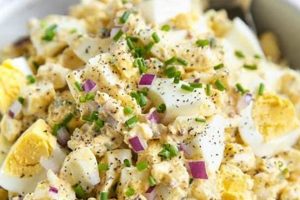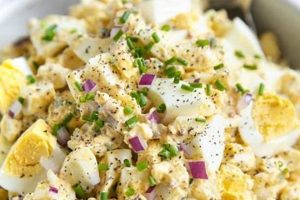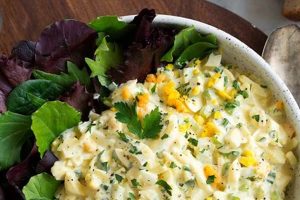A combination of chopped hard-boiled eggs, mayonnaise, and seasonings served between slices of bread constitutes a classic lunchtime staple. Variations often include mustard, celery, onion, relish, or spices like paprika and black pepper. Recipes range from simple to elaborate, offering customization based on personal preferences and dietary needs.
This easily prepared dish provides a substantial source of protein and offers versatility. It can be a quick weekday lunch, a picnic staple, or part of a larger buffet. Historically, egg salad emerged as a popular dish in the early 20th century, aligning with the growing accessibility of refrigeration and mayonnaise. Its affordability and adaptable nature have solidified its place in culinary history.
The following sections will explore various preparation methods, ingredient selections, and tips for creating the perfect version of this beloved dish. Discussions will also include nutritional information, variations for dietary restrictions, and creative serving suggestions.
Tips for Perfect Egg Salad
Achieving optimal flavor and texture requires attention to detail throughout the preparation process. These tips offer guidance for creating a superior egg salad.
Tip 1: Perfect Hard-Boiled Eggs: Avoid overcooking eggs, which can lead to a rubbery texture and a green ring around the yolk. Gently simmer eggs for 8-10 minutes, then immediately transfer them to an ice bath to stop the cooking process.
Tip 2: Proper Chopping Technique: A consistent chop ensures even distribution of flavor and a pleasant texture. Use a sharp knife or an egg slicer for uniform pieces. Avoid overly fine chopping, which can result in a mushy consistency.
Tip 3: Mayonnaise Selection: The quality of mayonnaise significantly impacts the final product. Choose a high-quality mayonnaise with a balanced flavor profile. Consider experimenting with different types, such as olive oil or avocado-based mayonnaise, for unique flavor nuances.
Tip 4: Seasoning Strategically: Salt and pepper are essential, but other seasonings can elevate the flavor. Consider adding a dash of Dijon mustard, paprika, or a pinch of cayenne pepper for added complexity.
Tip 5: Fresh Ingredients: Incorporating fresh herbs, such as dill or chives, can enhance the flavor and add visual appeal. Similarly, using crisp, fresh vegetables like celery or red onion provides textural contrast.
Tip 6: Proper Storage: Store egg salad in an airtight container in the refrigerator for up to 3 days. Avoid leaving it at room temperature for extended periods to prevent bacterial growth.
By following these tips, one can ensure a delicious and satisfying egg salad experience. Attention to detail in each step contributes to the overall quality and enjoyment of this versatile dish.
The following section will offer various serving suggestions and recipe variations to further enhance culinary creativity.
1. Fresh Ingredients
The quality of an egg salad sandwich hinges directly on the freshness of its components. Fresh ingredients contribute not only to superior flavor but also to a safer and more enjoyable culinary experience. Eggs, the foundational element, should ideally be recently purchased and properly refrigerated. Their freshness impacts both taste and texture, contributing to a smoother, more palatable final product. Similarly, mayonnaise, a crucial binding agent, benefits from freshness, offering a brighter flavor and smoother consistency. Wilted or aged produce, such as celery or onion, can detract from the overall quality, introducing off-flavors and unpleasant textures. For example, using farm-fresh eggs and freshly made mayonnaise noticeably elevates the taste and texture compared to using store-bought, pre-made ingredients.
Beyond flavor and texture, ingredient freshness impacts food safety. Eggs, particularly when used in a preparation like egg salad that isn’t cooked after mixing, present a potential risk of salmonella contamination if not handled and stored correctly. Fresh, properly refrigerated eggs minimize this risk. Similarly, using fresh produce reduces the likelihood of incorporating spoiled ingredients, which can harbor harmful bacteria. Furthermore, the overall shelf-life of egg salad is directly related to the freshness of its components. Beginning with high-quality, fresh ingredients extends the period during which the egg salad remains safe and enjoyable to consume. Using older ingredients can lead to faster spoilage and a shorter window for consumption.
Prioritizing fresh ingredients in egg salad preparation optimizes both flavor and safety. The difference between an egg salad made with fresh, high-quality components and one made with older or less carefully sourced ingredients is significant. Consumers benefit from a more satisfying sensory experience while minimizing potential health risks. This understanding underscores the importance of selecting fresh ingredients as a cornerstone of creating a truly excellent egg salad sandwich.
2. Proper Egg Cooking
Proper egg cooking is paramount to a successful egg salad sandwich. The texture and flavor of the finished product depend heavily on how the eggs are prepared. Overcooked eggs become rubbery and dry, resulting in a less palatable egg salad. Undercooked eggs, while potentially safe to consume on their own, introduce an undesirable runny texture and off-putting appearance when mixed with other ingredients.
- Timing and Temperature:
Precise timing and controlled temperature are essential for achieving the perfect hard-boiled egg. A consistent cooking time, typically 8-10 minutes at a rolling boil, ensures the egg white solidifies completely while the yolk remains creamy and avoids developing a green ring caused by overcooking. Variations in cooking time may be required depending on altitude and stovetop performance.
- Cooling Technique:
Immediately transferring cooked eggs to an ice bath halts the cooking process and prevents the aforementioned rubbery texture. This rapid cooling also helps the egg separate cleanly from the shell, simplifying the peeling process. The ice bath should contain enough ice and water to fully submerge the eggs for effective cooling.
- Peeling Method:
Gentle handling during the peeling process prevents damage to the egg white, maintaining a smooth and aesthetically pleasing appearance. Tapping the egg gently on a hard surface and rolling it between the palms can help loosen the shell. Peeling under cold running water can also assist in removing small shell fragments.
- Freshness of Eggs:
While not directly related to the cooking process itself, the freshness of the eggs impacts how they cook and ultimately how they perform in the egg salad. Fresher eggs are generally easier to peel and hold their shape better after cooking, contributing to a more visually appealing and texturally satisfying egg salad. Older eggs may be more difficult to peel and yield a less desirable texture.
By mastering these facets of egg cooking, one ensures a firm yet creamy egg, ideal for chopping and incorporating into a delicious egg salad sandwich. The attention to detail in this initial stage significantly elevates the final product, guaranteeing a superior culinary experience.
3. Balanced Seasoning
Balanced seasoning elevates an egg salad sandwich from simple to exceptional. It’s not merely about adding salt and pepper; it’s about a nuanced approach that enhances the inherent flavors of the eggs, mayonnaise, and other ingredients. A thoughtfully seasoned egg salad offers a more complex and satisfying flavor profile, transforming a basic lunch item into a culinary delight.
- Salt and Pepper Foundation
Salt and freshly ground black pepper serve as the foundational seasoning elements in egg salad. Salt enhances the natural flavors of the eggs and other ingredients, while pepper adds a subtle bite and depth. The key is to season gradually, tasting and adjusting as needed, to avoid over-salting or overpowering the delicate flavors.
- Acidity and Brightness
A touch of acidity brightens the richness of the mayonnaise and egg yolks. A squeeze of lemon juice, a dash of white wine vinegar, or a teaspoon of Dijon mustard can provide this necessary balance. These acidic elements cut through the richness, adding a refreshing counterpoint to the creamy texture.
- Aromatic Complexity
Incorporating aromatic ingredients adds layers of complexity to the flavor profile. Fresh herbs like dill, chives, or parsley contribute a fresh, herbaceous note. Spices such as paprika, celery seed, or a pinch of cayenne pepper offer warmth and depth. These additions should be used judiciously to complement rather than overwhelm the other flavors.
- Balancing Sweetness and Savory
A hint of sweetness can balance the savory elements in an egg salad. A finely diced sweet pickle relish or a touch of finely chopped red onion introduces subtle sweetness without overpowering the other flavors. This balance creates a more rounded and satisfying flavor experience.
Careful consideration of these seasoning elements transforms an egg salad sandwich into a more complex and flavorful experience. The interplay of salt, acid, aromatics, and a touch of sweetness creates a harmonious balance that enhances the overall enjoyment of this classic dish. Experimentation with different combinations of seasonings allows for customization and the discovery of personal flavor preferences.
4. Quality Bread Choice
Bread serves as the structural foundation and flavor canvas of an egg salad sandwich. Quality bread choice significantly impacts the overall sensory experience. Structural integrity is crucial; the bread must hold the egg salad without becoming soggy or crumbling. Flavor compatibility is equally important; the bread’s taste should complement, not overpower, the egg salad’s delicate flavors. A sturdy, flavorful bread enhances enjoyment, while a poor choice detracts from the overall quality. For instance, a thinly sliced white bread might lack the structural integrity to contain a generous portion of egg salad, leading to a messy eating experience. Conversely, a dense, sourdough loaf, while structurally sound, might overpower the subtle flavors of the egg salad.
Consider texture and flavor when selecting bread. A classic choice, such as challah or brioche, offers a soft, slightly sweet counterpoint to the savory egg salad. Whole-wheat or multigrain breads provide a nuttier flavor and more robust texture. Rye bread adds a distinct, slightly tangy dimension. Ultimately, the best bread depends on individual preference and the specific egg salad recipe. Matching the bread’s density and flavor profile to the egg salad ensures a harmonious and enjoyable combination. A crusty baguette, for example, might pair well with a coarsely chopped egg salad featuring Dijon mustard and cornichons, while a soft potato roll might better complement a creamy, classic egg salad.
Selecting appropriate bread elevates the egg salad sandwich from a simple meal to a culinary experience. The interplay of textures and flavors between the bread and the filling creates a synergistic effect, enhancing overall enjoyment. Careful consideration of bread choice demonstrates an attention to detail that transforms a commonplace sandwich into a carefully crafted culinary creation. Ignoring this crucial element risks compromising the structural integrity and flavor balance, ultimately diminishing the pleasure of consuming this classic dish. Therefore, understanding the impact of bread choice empowers individuals to create a truly satisfying and memorable egg salad sandwich experience.
5. Mayonnaise Selection
Mayonnaise functions as the unifying element within an egg salad sandwich, binding the chopped eggs and other ingredients while contributing significantly to the overall flavor and texture. Selection of an appropriate mayonnaise is therefore crucial. The quality and type of mayonnaise directly impact the final product’s richness, tanginess, and creaminess. A bland or low-quality mayonnaise can result in a dull, uninspired egg salad, while a mayonnaise with excessive tang or sweetness can overpower the delicate egg flavor. For instance, using a light mayonnaise might create a less rich and flavorful egg salad compared to a full-fat version. Similarly, choosing a mayonnaise with added flavors, such as chipotle or lemon, can significantly alter the overall taste profile.
Various factors influence mayonnaise selection. Fat content plays a key role in determining richness and mouthfeel. Full-fat mayonnaise creates a luxuriously creamy texture, while lower-fat versions offer a lighter, less decadent experience. Flavor profiles also vary significantly. Classic mayonnaise provides a neutral backdrop for other ingredients, while flavored mayonnaises, such as those infused with herbs or spices, can add complexity and depth. Ingredient quality is another important consideration. Mayonnaises made with high-quality oils and minimal additives often possess a cleaner, more refined taste compared to those containing artificial ingredients or preservatives. For example, an egg salad intended for a delicate tea sandwich might benefit from a light, subtly flavored mayonnaise, while a heartier sandwich served on rustic bread could handle a bolder, more robust mayonnaise.
Understanding the impact of mayonnaise selection empowers informed decision-making. By carefully considering factors such as fat content, flavor profile, and ingredient quality, individuals can select the ideal mayonnaise to complement their specific egg salad recipe and achieve the desired outcome. Recognizing the crucial role mayonnaise plays in binding, flavoring, and texturizing egg salad elevates preparation beyond mere assembly and transforms it into a nuanced culinary endeavor. The choice of mayonnaise can make or break an egg salad sandwich, highlighting its significance in crafting a truly exceptional final product.
6. Texture Considerations
Texture significantly impacts the palatability and overall enjoyment of an egg salad sandwich. The interplay of textures, from the creaminess of the mayonnaise to the firmness of the eggs and the potential addition of crisp vegetables, creates a multi-sensory eating experience. A harmonious balance of textures contributes to a more satisfying and enjoyable sandwich, while an imbalance can result in a less appealing or even unpleasant outcome. For example, an egg salad with overly mushy eggs and a lack of textural contrast can feel heavy and unappetizing. Conversely, an egg salad with excessively large egg chunks and crunchy vegetables might feel disjointed and lack cohesion.
Several factors contribute to textural variation in egg salad. The size of the chopped eggs plays a key role. Finely chopped eggs create a smoother, more uniform texture, while coarsely chopped eggs offer a more substantial, chunkier mouthfeel. The addition of ingredients such as celery, red onion, or pickles introduces contrasting crunchy elements. These crisp additions provide textural complexity, preventing the egg salad from becoming monotonous. The type of mayonnaise used also influences texture. A thicker mayonnaise contributes to a creamier, richer consistency, while a thinner mayonnaise results in a lighter, less dense texture. The ratio of mayonnaise to egg also affects the final texture, with a higher proportion of mayonnaise leading to a creamier, smoother result.
Achieving desired textural outcomes requires careful consideration of these elements. Controlling egg chop size, incorporating contrasting ingredients, and selecting an appropriate mayonnaise allows for precise tailoring of texture. Understanding the interplay of these factors allows for the creation of an egg salad with a texture that complements individual preferences and enhances overall enjoyment. Whether one prefers a smooth, creamy egg salad or a chunkier, more textured version, attention to detail in preparation ensures a satisfying culinary experience. A well-executed balance of textures elevates the simple egg salad sandwich from basic sustenance to a truly delightful culinary creation.
7. Creative Additions
Creative additions transform a standard egg salad sandwich into a personalized culinary expression. These additions, ranging from spices and herbs to fruits and vegetables, introduce complexity and depth of flavor while also offering textural variations. Thoughtful incorporation of such elements elevates the sandwich beyond basic sustenance, creating a more engaging and satisfying dining experience. Exploration of these creative additions reveals the potential for customization and flavor exploration within the seemingly simple egg salad sandwich.
- Herbs and Spices
Fresh herbs, such as dill, chives, parsley, or tarragon, introduce bright, herbaceous notes that complement the richness of the eggs and mayonnaise. Spices, including paprika, cayenne pepper, or curry powder, add warmth and depth, creating a more complex flavor profile. The selection of herbs and spices should consider the overall flavor profile desired, ranging from classic to adventurous.
- Fruits and Vegetables
Incorporating finely diced fruits or vegetables adds textural contrast and flavor dimension. Apples, grapes, or dried cranberries introduce sweetness and a pleasant chewiness. Chopped celery, red onion, or water chestnuts offer crispness and a refreshing counterpoint to the creamy egg salad. These additions not only enhance flavor but also contribute to a more visually appealing sandwich.
- Nuts and Seeds
Toasted nuts or seeds provide a satisfying crunch and nutty flavor. Chopped walnuts, pecans, or sunflower seeds add textural complexity and enhance the overall nutritional value of the sandwich. The choice of nuts or seeds should complement the other flavors present in the egg salad.
- Flavorful Enhancers
Other additions can further enhance the flavor profile of the egg salad. A dash of hot sauce introduces heat, while a spoonful of capers or olives adds a briny, salty element. Crumbled bacon or chopped ham contributes a smoky, savory dimension. These additions offer opportunities for customization and allow for the creation of unique flavor combinations.
By thoughtfully incorporating creative additions, individuals can personalize the egg salad sandwich to reflect their individual preferences and culinary creativity. These additions elevate the sandwich beyond a simple staple, transforming it into a versatile and exciting culinary canvas. The possibilities for customization are vast, limited only by imagination and a willingness to experiment with different flavor combinations and textural contrasts. The result is a more engaging and satisfying dining experience that celebrates the potential for culinary exploration within the seemingly humble egg salad sandwich.
Frequently Asked Questions
This section addresses common inquiries regarding preparation, storage, and variations of egg salad sandwiches. Understanding these aspects ensures optimal results and addresses potential safety concerns.
Question 1: How long can egg salad be safely stored?
Properly stored egg salad, kept in an airtight container refrigerated at 40F (4C) or below, typically remains safe for consumption for up to 3-5 days. Beyond this timeframe, the risk of bacterial growth increases significantly.
Question 2: What are signs that egg salad has spoiled?
Spoiled egg salad often exhibits a sour or off-putting odor. Changes in texture, such as excessive sliminess or dryness, also indicate spoilage. Discoloration or the presence of mold signifies definitive spoilage. If any of these signs are present, discard the egg salad immediately.
Question 3: Can egg salad be frozen?
Freezing egg salad is generally not recommended. The mayonnaise-based dressing separates upon thawing, resulting in a watery, less desirable texture. The eggs themselves can also become rubbery after freezing.
Question 4: How can one prevent rubbery eggs in egg salad?
Preventing rubbery eggs requires precise cooking. Simmer eggs for 8-10 minutes, then immediately transfer them to an ice bath to stop the cooking process. Overcooking results in a rubbery texture.
Question 5: What are common alternatives to mayonnaise in egg salad?
Alternatives to mayonnaise include plain Greek yogurt, mashed avocado, or a combination of olive oil and lemon juice. These options offer different flavor profiles and varying degrees of creaminess.
Question 6: How can egg salad be made healthier?
Healthier egg salad variations incorporate reduced-fat mayonnaise, plain Greek yogurt, or avocado. Increasing the proportion of vegetables, such as celery or bell peppers, also enhances nutritional value.
Understanding these frequently asked questions empowers individuals to prepare, store, and enjoy egg salad safely and effectively. Attention to these details ensures optimal flavor, texture, and food safety practices.
This concludes the frequently asked questions section. The following section offers a collection of curated egg salad recipes.
Egg Salad Recipe Sandwich
This exploration has delved into the multifaceted nature of the egg salad sandwich, examining its core components and the nuances that elevate it from simple fare to a satisfying culinary creation. From the importance of fresh ingredients and proper egg cooking techniques to the balanced interplay of seasonings and the considered selection of bread and mayonnaise, each element contributes to the final product’s overall quality. Furthermore, the potential for creative additions, incorporating herbs, spices, fruits, and vegetables, allows for personalized flavor profiles and textural variations, transforming the egg salad sandwich into a versatile culinary canvas.
The egg salad sandwich, despite its apparent simplicity, offers a remarkable opportunity for culinary exploration and personal expression. Attention to detail in each stage of preparation, from ingredient selection to assembly, yields a significantly enhanced dining experience. This exploration encourages a deeper appreciation for this classic dish and empowers individuals to create egg salad sandwiches that transcend the ordinary and embrace the extraordinary.






